It’s a sight to behold, day or night, or anywhere in sight! Made with the utmost love and passion, studded with semi-precious stones, they have withstood the test of time and have only got more popular over the centuries. In fact, not just fame, they have become synonymous with our great city of Hyderabad, the land of the Nawabs!
Hyderabad itself is known for its bangles made of glass and lacquer, and studded with stones. Lac bangles, then and now, from time immemorial have continued to literally lure not just local citizens but the innumerable tourists who have to and love to pay a visit to the very legendary Laad Bazaar.
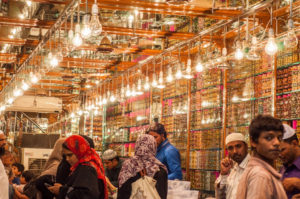 Bangles, traditional ornaments worn by women are the essence of womanhood and a tradition that has continued since ages. And every woman in the world who has seen lac bangles, would like and love to wear these Hyderabadi bangles as it adds more charm and glory to her. With their appealing colours and cultural patterns, lac bangles have become more fashionable for today’s jet-set women. Keeping a check on the latest trends from across the country and the globe, the lac bangle-makers have adapted from old to modern trends with beautiful artificial diamonds.
Bangles, traditional ornaments worn by women are the essence of womanhood and a tradition that has continued since ages. And every woman in the world who has seen lac bangles, would like and love to wear these Hyderabadi bangles as it adds more charm and glory to her. With their appealing colours and cultural patterns, lac bangles have become more fashionable for today’s jet-set women. Keeping a check on the latest trends from across the country and the globe, the lac bangle-makers have adapted from old to modern trends with beautiful artificial diamonds.
Bangles are circular in shape, and, unlike bracelets, are not flexible and it is said that the word is derived from the Hindi word bungri (glass). Bangles have rightly so, become a fashion accessory with a wide range of designs such as glass bangles, kundan bangles, wedding bangles, ethnic bangles, Indian wedding bangles, designer bangles, fashion bangles, love bangles, Bollywood bangles, Indian bangle bracelets, pearl bangles, plastic bangles, bamboo bangles, 22k gold bangles……the list goes on.
But somehow, holding their own stead and rightfully so with regale are the lac bangles, which completely outshine the rest. Beating the rest by huge numbers, sales and designs, the lac bangle makers are not far behind in creating magic with it. The trend of starting a trend holds well in lac bangles too, for they have a wide range that is hard to beat.
 Lac bangles have a touch of class and richness. Extremely popular with intricate detailing of master craftsmanship, they are the most sought after items and studded with stones, and what have you; they are as lavish and glorious as their metal counterparts.
Lac bangles have a touch of class and richness. Extremely popular with intricate detailing of master craftsmanship, they are the most sought after items and studded with stones, and what have you; they are as lavish and glorious as their metal counterparts.
Going Down History With Lac Bangles
Bangles made from lac are said to be one of the oldest ones and among the brittle category too. Lac has been and is popular due to it being the oldest source of colour, its pliability, its advantage of adding other colours or embellishments to it and of course its cheap prices. It is said that lac bangles have been made since the 15th Century in our region. The known type of process involved in making lac bangles is the hand-crafted method of using a mould.
According to an article by Dr. P Jogi Naidu of the Archaeology and Museums Andhra Pradesh, the origin of this great craft goes back to the days of the Qutub Shahi era. It states that the pioneers came to the city as hakims to cure people (which was their primary occupation) and bangle making acquired the form of a subsidiary one. However, there are other tales too, to their origin.
 Another one, as per the author of the Bangle Char Chaman, Mohd. Hussain, says that “As the trade relations between Golconda and Persia were cordial, a group of Persians, whose main occupation was hakim and subsidiary occupation was bangle making, came to Golconda at the invitation of the King and settled down here. Therefore bangle making as an industry started in Hyderabad during the Qutub Shahi period.”
Another one, as per the author of the Bangle Char Chaman, Mohd. Hussain, says that “As the trade relations between Golconda and Persia were cordial, a group of Persians, whose main occupation was hakim and subsidiary occupation was bangle making, came to Golconda at the invitation of the King and settled down here. Therefore bangle making as an industry started in Hyderabad during the Qutub Shahi period.”
Yet another version is that, there were regular trade ties between the Golconda and Vijayanagara Kingdoms in the 15th and 16th Centuries and during this period Vijayanagara was the main centre for manufacturing glass bangles which were brought to Golconda, the main market place in those days.
There are yet other historians that state that this craft originated in Rajasthan during the 17th Century and Mumtaz Mahal, the Mughal empress, was a great patron of beaded bangles and set the fashion trend among the nobility at that time.
Whatever is the history or the story behind the great craft of lac bangle making, one thing for sure is that, they will remain for time immemorial and continue to entice its wearers.
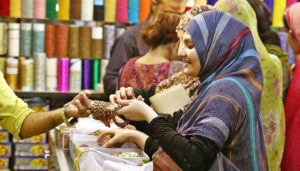 Laad Bazaar, the ‘Street of Love’
Laad Bazaar, the ‘Street of Love’
Laad Bazaar or Choodi Bazaar is a very old market popular for bangles located in Hyderabad and is on one of the four main roads that branch out from the historic Charminar.
While it is popularly believed that laad means lacquer (which is used to make bangles); according to local artisans it is said that Laad Bazaar got its name about 150 years ago during the time of the Sixth Nizam, Mir Mehabub Ali Khan and it also then that the craft of lac bangle making originated. To add credibility to their story, they say, is the fact that it was in Laad Bazaar that the Chowmahalla Royal Palace was constructed to house the ruling Nizam. And hence it was but natural to call the street Laad Bazaar or Street of Love or Bazaar of Fondness.
The one kilometre stretch shopping strip, houses most of the shops that sell lac bangles and other items like saris, wedding related items and cheap imitation jewellery.
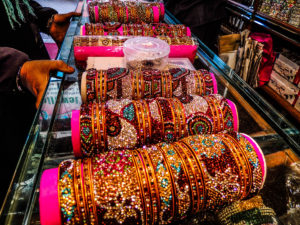 According to estimates, currently, more than 15,000 people are employed by this street of bangles alone as compared to a work strength of 200 to 250 people a decade ago. It is estimated that on an average about 500 to 800 foreign and local tourists visit the bazaar each day. With the increasing demand for the bangles of Hyderabad, customers for Choodi Bazaar is getting higher and higher by the day.
According to estimates, currently, more than 15,000 people are employed by this street of bangles alone as compared to a work strength of 200 to 250 people a decade ago. It is estimated that on an average about 500 to 800 foreign and local tourists visit the bazaar each day. With the increasing demand for the bangles of Hyderabad, customers for Choodi Bazaar is getting higher and higher by the day.
The craft has acquired the form of a small-scale industry now and there are thousands of workers in Old City who earn a livelihood by making these lac bangles. They are part of the unorganised sector and work out of small units, usually their homes. In many families, it is a family affair and the whole family comes together to help and make the final lac bangles; while in other cases members of different families come together to work. They are then sent to the shop keepers to sell. The shopkeepers give a commission to the bangle-makers and the glimmering bangles are sold for outstanding profit margins.
Most shopkeepers sell the bangles as a pair, leaving it to the choice of the customer to mix and match the bangles the way they want it. While the thick bangles are sold in singles, the thin ones can be purchased in sets of six, 10 or 12.
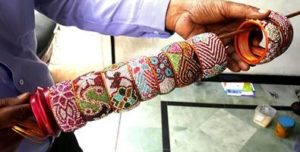 Enter the small stretch and you will literally be beckoned by the sellers to come and see their bangles, many a times with a ‘Kya hona Madam!’ (What do you want, Madam?) Bargaining and haggling for the best price is a part of the game in this market that knows how to keep their customers happy. Some stores are furnished with a clean, soft cotton mattress where customers can sit and the sales person will show you what you want.
Enter the small stretch and you will literally be beckoned by the sellers to come and see their bangles, many a times with a ‘Kya hona Madam!’ (What do you want, Madam?) Bargaining and haggling for the best price is a part of the game in this market that knows how to keep their customers happy. Some stores are furnished with a clean, soft cotton mattress where customers can sit and the sales person will show you what you want.
To enable free flow of customers here, auto rickshaws and cars are barred entrance from Charminar end and only pedestrians, bicycles, motorcycles and scooters are permitted.
What is Lac?
Lac is a clay-like material which is moulded in hot kilns-like places to make these bangles. Lac is a resinous secretion of Lac-producing insects such as Laccifer lacca, Carteria lacca and Tachardia lacca. These plant-sucking insects colonize on the branches of host trees to produce scarlet resinous pigment. Later the coated branches of the host trees are cut and harvested as sticklac. These sticklac are crushed, sieved and washed several times to remove impurities.
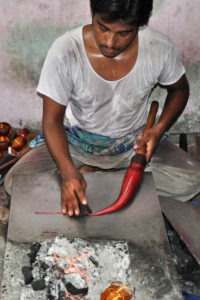 Lac is the source of resin, wax, and dye. It collected from forests in Bihar, Madhya Pradesh, Uttar Pradesh, Maharashtra, Orissa, West Bengal, and Assam. It is available in different qualities, dark black, brown and light golden, the latter being the best and most expensive. It is sold at anything between Rs. 200 per kg to Rs. 400 a kg and stays fresh and malleable for about roughly a year.
Lac is the source of resin, wax, and dye. It collected from forests in Bihar, Madhya Pradesh, Uttar Pradesh, Maharashtra, Orissa, West Bengal, and Assam. It is available in different qualities, dark black, brown and light golden, the latter being the best and most expensive. It is sold at anything between Rs. 200 per kg to Rs. 400 a kg and stays fresh and malleable for about roughly a year.
Reference to lac can be found in Vedas too and the Atharvaveda provides a detailed account of lac, its production and uses. Ayurveda stresses the importance of lac in medical therapies. India is one of the largest producers of lac and its principal exporter. It is widely used in food processing, textile, leather, cosmetics, varnish and printing industries. Being bio-degradable and eco-friendly its usage is becoming highly popular by the day.
How Are Lac Bangles Made?
Raw materials like chapdi (black lac), orange chapdi (light golden lac), beroza, giya pathar powder, coal, sequins, semi- precious stones and colours in powder form; pevdi (yellow), safeda (lithophone), mirgam (copper), green, chamki (gold) are used in the making. Tools used are angethi (coal burner with flat steel plates/silla on top), kadai (shallow vessel), wooden rod, stone piece, hattha for pressing and shaping lac, iron bangles for sizing, tin foil, round wooden rod/khali for shaping bangles, cutter, tool for picking sequins, haddi or bone shaped wooden tool.
 The process is that first the lac pieces are melted in a shallow vessel or kadai. When it is in a semi-molten state, the desired colours and beroza, giya pathar powder are added to it. The mixture is then stirred continuously. The coloured lac is now stuck on the end of a wooden stick and left to dry. The lac (without pigment) stuck around a wooden rod is heated slowly over the coal burner or angethi and is simultaneously pressed with a stone or a wooden tool called hattha at regular intervals. When it is sufficiently warm and soft, it is wrapped with the desired colour by rubbing the coloured lac stick on it evenly.
The process is that first the lac pieces are melted in a shallow vessel or kadai. When it is in a semi-molten state, the desired colours and beroza, giya pathar powder are added to it. The mixture is then stirred continuously. The coloured lac is now stuck on the end of a wooden stick and left to dry. The lac (without pigment) stuck around a wooden rod is heated slowly over the coal burner or angethi and is simultaneously pressed with a stone or a wooden tool called hattha at regular intervals. When it is sufficiently warm and soft, it is wrapped with the desired colour by rubbing the coloured lac stick on it evenly.
For this purpose the coloured lac stick also has to be warm enough and is therefore heated over the burner when needed. After the colour has been applied to the lac base it is shaped into a thin coil with the help of the hattha and cut off from the plain lac rod. The coil is then heated over the burner so that the ends can be joined together to form a bangle. While it is still hot, a plain golden coloured metal bangle, sona bai, is slipped inside the lac bangle to strengthen it. After being joined it is slipped through a round wooden beam (with a tapering end for different sizes) and adjusted for size.
 The bangle is now ready to be embellished with sequins, semi-precious stones or whatever is desired. The sequins are placed on a tin foil and heated over a burner. They are warmed so that they can melt the lac surface on which they are placed and stick there after solidification. They are picked up one at a time and stuck on the bangle according to the design chosen. The process requires great precision and practice and is hard for a first time user to even attempt to make. It takes much longer when working with smaller sized sequins.
The bangle is now ready to be embellished with sequins, semi-precious stones or whatever is desired. The sequins are placed on a tin foil and heated over a burner. They are warmed so that they can melt the lac surface on which they are placed and stick there after solidification. They are picked up one at a time and stuck on the bangle according to the design chosen. The process requires great precision and practice and is hard for a first time user to even attempt to make. It takes much longer when working with smaller sized sequins.
Bangle-making is a laborious process and most of it is done by men. Once the bangles, in various shapes and sizes, have been crafted by the men, they are embellished with shiny artificial stones, beads and glass fragments in a riot of colourful patterns by the women, who meticulously affix each of these tiny pieces onto the warm, one-inch, or even less, lac base.
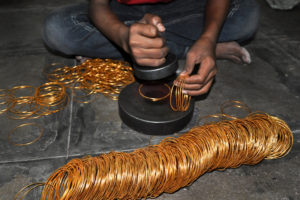 A basic set of bangles can be made in about 20 minutes. During the entire process, the material is repeatedly heated over coals so that it stays malleable. The melting and mixing is done on kerosene stoves. Over 180 bangles are crafted out of a kg of lac powder bought for Rs 350. The colours cost about Rs 200 a kg and can be used for almost 1,000 bangles. Sometimes, the colours used for Holi festival are used too in getting newer and different colours.
A basic set of bangles can be made in about 20 minutes. During the entire process, the material is repeatedly heated over coals so that it stays malleable. The melting and mixing is done on kerosene stoves. Over 180 bangles are crafted out of a kg of lac powder bought for Rs 350. The colours cost about Rs 200 a kg and can be used for almost 1,000 bangles. Sometimes, the colours used for Holi festival are used too in getting newer and different colours.
For the lac bangles, as many as 300 colours can be made from the basic seven to eight colours, by mixing and matching them in various permutations and combinations. Colours like rosam kala, pila rosam, kali chapdi, chapdi, golden chapdi, gulabi, blue, khuleri, golden neela, pearl, gulabi heer, titanium, safeda etc. are to name a few.
An interesting fact in the process of making lac bangles is that, out of all the processes involved, only the sona bai bangle is made by machine. The rest of the process is all by hand, which makes it all the more unique and beautiful.
 The Lac Craft
The Lac Craft
Other regions in the country that make the popular lac bangles are Gujarat, Rajasthan and Bihar. It is said that Lakhera or Laheri is the hereditary artisan community of Hindus involved in lac bangle making.
Apart from lac jewellery items like bangles, necklaces and earrings, other decorative and utility items are also made from lac; like boxes, mirrors, photo frames, key chains, pens, penholders, tea coasters, notebooks, phone books, etc. Another item called the ‘rakhi’ (a small red bead kind of piece) is also made which is worn during Marwari weddings by both the boy and girl.
Lac Bangles Importance
Lac bangles are considered auspicious in several cultures of the country and therefore popular during marriage ceremonies in regions like Rajasthan, Hyderabad and Bihar. They are considered a sign of good omen and are worn by married women on all auspicious occasions in Gujarat and Rajasthan; where red and green are the traditional colours.
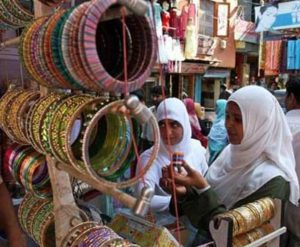 In Rajasthan lac bangles continue to be popular among married women and are preferred as they are soothing to wear and do not cause infections or itchiness like in the case of plastic or glass bangles. Worn in ceremonial functions, traditional designs are popular. Traditional colours have been replaced by a whole array of pastels and other colours which are now preferred by customers.
In Rajasthan lac bangles continue to be popular among married women and are preferred as they are soothing to wear and do not cause infections or itchiness like in the case of plastic or glass bangles. Worn in ceremonial functions, traditional designs are popular. Traditional colours have been replaced by a whole array of pastels and other colours which are now preferred by customers.
Sequins, semi-precious stones and glass work on lac bangles is quite popular today in Rajasthan and Hyderabad. The demand for lac bangles has increased in the international market and a number of lac artisans have migrated to Gulf countries from Hyderabad in search of bangle making jobs. However, utility products made out of lac such as tea coasters, boxes, notebooks, etc are gaining popularity too.
Designer lacquer bangles come in various hues and tones like red, green, black, blue etc. and are available in an exclusive range of ethnic designs. With intricate designs some have rhinestone crystal, artificial diamonds, pearls and mirror work. From teens to working women to housewives, everyone wants to embrace the magic of lac bangles. In fact, if you are getting married in Hyderabad, the lac bangle is considered a must in the wardrobe.
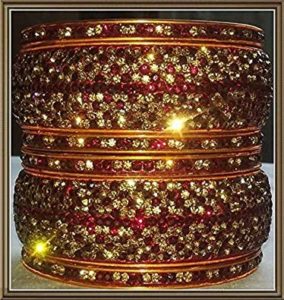 Lac Bangle Merchants’ Say
Lac Bangle Merchants’ Say
The first thing that a seller of lac bangles, Mohd. Mazhar Ali Khan (whose family has been in the lac bangle selling business for over 30 years), says is “Madam, glass bangles aged aurathon aur daily wear ke liye hain, aap ke liye nahin. (Madam, glass bangles are for the aged women and for daily use only, not for young people like you).” Then he immediately adds with a smile, even as he reaches out a glittering and shiny bangle and says “yeh bangles arash (chamki or glitter) ke saath aacha hain, party wear ke liye. (These bangles with glitter are good for party wear).”
Keen on showing off his knowledge about lac bangles, he relays the price range for all the bangles by the dozen. So, you have plain bangles at Rs. 25 per dozen, the ones with kundan work at Rs. 75 per dozen, the ones with springs are at Rs. 75 per dozen, the ones with glass and stones stuck on it are at Rs. 150 for four bangles. Coming to the lac bangles, they are priced anywhere between Rs. 250 for six bangles (studded with Chinese white stones) to Rs. 470 for six bangles (studded with normal, shiny and colourful stones) to Rs. 750 (no less!) for six bangles (studded with real American diamonds). Goes without saying that as the price keeps going higher, everything from the quality of the products used to the fine craftsmanship is of the topmost quality and definitely worth the high price!
 When I state the same, he says, “Ek minute Madam, kuch aur dikhayenge. (One minute Madam, I want to show you something else).” Sure enough it was a sight to behold. A ‘family set’ (as it is called) of 14 bangles with bright and shiny stones set in a lovely colour, was fetched out from a cupboard to be shown to me. “Yeh sirf Rs. 1400 ka hain, Madamji. (This is only for Rs. 1400, Madam),” he says with a big grin. His brother Jahangir Ali Khan says, “Hum order bhi lethe hain Madam. Aap ko job hi chahiye, hum teen ghante mein kar ke denge. (We also undertake personalized orders. Whatever you want, we can make it and give it you in about three hours time.” He then adds, “Family set ke saath, aap sona bai chudiyaan zaroor pehenna. Sona bai bangle kisi bhi bangle ka shaan hain. (For the family set, wear it along with the sona bai bangles. Sona bai bangles are the charm of any bangle set.)” Sona bai bangles are light, golden coloured metal bangles that gel with any bangles and make it even more brighter and appealing; and are sold at a throw-away price of Rs. 25 per dozen.
When I state the same, he says, “Ek minute Madam, kuch aur dikhayenge. (One minute Madam, I want to show you something else).” Sure enough it was a sight to behold. A ‘family set’ (as it is called) of 14 bangles with bright and shiny stones set in a lovely colour, was fetched out from a cupboard to be shown to me. “Yeh sirf Rs. 1400 ka hain, Madamji. (This is only for Rs. 1400, Madam),” he says with a big grin. His brother Jahangir Ali Khan says, “Hum order bhi lethe hain Madam. Aap ko job hi chahiye, hum teen ghante mein kar ke denge. (We also undertake personalized orders. Whatever you want, we can make it and give it you in about three hours time.” He then adds, “Family set ke saath, aap sona bai chudiyaan zaroor pehenna. Sona bai bangle kisi bhi bangle ka shaan hain. (For the family set, wear it along with the sona bai bangles. Sona bai bangles are the charm of any bangle set.)” Sona bai bangles are light, golden coloured metal bangles that gel with any bangles and make it even more brighter and appealing; and are sold at a throw-away price of Rs. 25 per dozen.
Another thing that has continued for generations is filling gold bangles with lac inside to make it stronger. Imtiaz of Barkat Bangles (who are exporters of lac bangles and function out of their home-cum-workshop) says, “We charge about Rs. 25 for each bangle. By filling in lac inside the hollow part of gold or silver bangles, it makes it stronger and sturdier.” Speaking about lac bangles themselves, he says, “I can make about two pairs in an hour. We are continuing our family heritage and have been involved in this business for over 90 years now, in the same house and same place.”
 How is it business wise? Both shop owners say that business is getting better and definitely much better than previous years. Sales have been on the rise and money is better nowadays. Keeping in touch with the times and changing trends of today, many bangle makers like Barkat Bangles also come to functions and celebrations (at a premium price) and make personalized bangles according to the customers’ needs. But here, they will only make the plain lac bangles, since the ones with studded stones are time-consuming and require more effort.
How is it business wise? Both shop owners say that business is getting better and definitely much better than previous years. Sales have been on the rise and money is better nowadays. Keeping in touch with the times and changing trends of today, many bangle makers like Barkat Bangles also come to functions and celebrations (at a premium price) and make personalized bangles according to the customers’ needs. But here, they will only make the plain lac bangles, since the ones with studded stones are time-consuming and require more effort.
By been part of event-managing companies to showcase the craft of lac bangle making, these craftsmen are glad that they can make some extra money by going to celebrations or even displaying their craft at hotels for tourists.
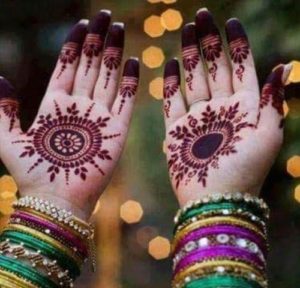 Your Lac Choice!
Your Lac Choice!
Head to Laad Bazaar, visit one of these age-old lac bangle makers and sellers and get adventurous. Pick, choose and create your bangle sets by mixing and matching what they have or even better sit with a lac bangle maker and craft your very own lac bangle, complete with your choicest embellishments, stones, springs, sequins or what have you?! What’s in your mind, will be adorning your hands. What’s more, it will give you the pleasure that you created your very own designer lac bangle set. So, go ahead and be a part of history, in your own sweet round way! #KhabarLive







